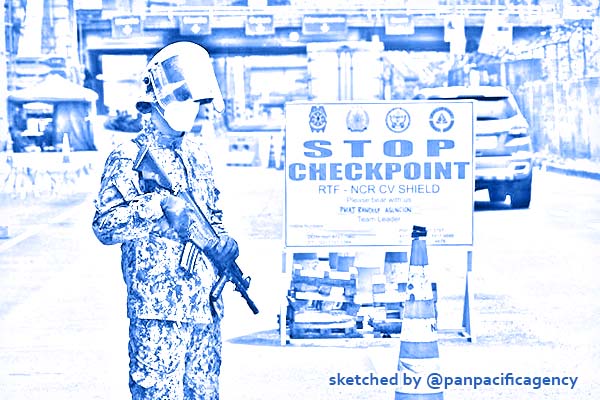Philippine govt eyes shift to new normal

IATF on Emerging Infectious Diseases is seeing good indicators that could merit the lifting of the enhanced community quarantine (ECQ) in many parts of Metro Manila, according to DILG spokesman and Undersecretary Jonathan Malaya. Soldier on the quarantine chekpoint in the Manila, Philippines. Photo: Boy Santos. Sketched by the Pan Pacific Agency.
MANILA, Jun 11, 2020, The Manila Times. Malacañang is considering shifting areas under modified general community quarantine (MGCQ) to the “new normal” as the nationwide community quarantine nears its end, Palace spokesman Harry Roque Jr. said, The Manila Times reported.
He said the Inter-Agency Task Force for the Management of Emerging Infectious Diseases (IATF-EID) would assess whether to downgrade the classification of community quarantine in places under MGCQ and general community quarantine (GCQ).
“We now have quite a number of provinces under MGCQ and GCQ. So when we talk about revisions, we’ll see if we can have a lower classification — new normal for those under MGCQ or MGCQ for those that are still in GCQ,” Roque said in a television interview.
The “new normal” is the next step when an area graduates from the MGCQ or when an area is no longer under community quarantine.
Roque said the IATF-EID’s decision on quarantine classifications beginning June 16 would depend on “scientific” data.
“The most important, of course, is what will happen on June 16 and I think the entire nation is clearly awaiting the decision of the IATF. Now, I would like to stress that actually, when we decide whether or not to ease further or to retain the classification is always scientific data,” he said.
The government earlier sought to relax the lockdown measures across the country, allowing more businesses to reopen and public transportation to resume at reduced capacity in a bid to jumpstart the economy.
After more than two months of strict lockdown, Metro Manila, Central Luzon, Cagayan Valley, Calabarzon (Cavite, Laguna, Batangas, Rizal and Quezon), Central Visayas, Pangasinan, Zamboanga City and Davao City have shifted to the more relaxed GCQ until June 15.
The rest of the country was placed under MGCQ, the lowest quarantine level implemented by the national government.
The IATF-EID is expected to present this week its recommendation to President Rodrigo Duterte on whether to lift, modify or extend the community quarantines enforced across the country.
Meanwhile, Roque said the task force would be “very careful” in assessing the situation in Metro Manila and Cebu City, where the number of coronavirus disease 2019 (Covid-19) cases continues to increase.
“I would say that these two areas — Metro Manila and Cebu City — would take quite some time in the discussion that will take place this afternoon,” Roque said.
“We’re still looking for some kind of data that would indicate that Metro Manila [and Cebu City] if we give [them] more liberty so to speak under the MGCQ, will not spark a second wave. We cannot afford a second wave,” he added.
The classification of community quarantine starting June 16, according to Roque, would be based on the case doubling rate and critical health care capacity.
He said the IATF-EID might allow the implementation of MGCQ in Metro Manila and Cebu City if it was proven that they could attend to the needs of people infected with Covid-19.
“Even if the numbers may be going up, if we have the capacity to take care of them (Covid-19 patients) in case they get sick really in a critical manner, it could still be decided that we could graduate to a lower degree of classification,” Roque said.